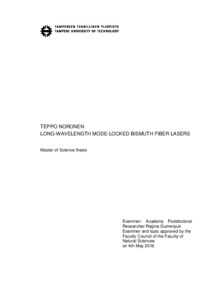Long-Wavelength Mode-Locked Bismuth Fiber Lasers
Noronen, Teppo (2016)
Noronen, Teppo
2016
Teknis-luonnontieteellinen koulutusohjelma
Luonnontieteiden tiedekunta - Faculty of Natural Sciences
This publication is copyrighted. You may download, display and print it for Your own personal use. Commercial use is prohibited.
Hyväksymispäivämäärä
2016-06-08
Julkaisun pysyvä osoite on
https://urn.fi/URN:NBN:fi:tty-201605254046
https://urn.fi/URN:NBN:fi:tty-201605254046
Tiivistelmä
Ultrafast lasers producing short, intense pulses are of great interest for both optical science community and laser industry. The applications of ultrafast lasers range from medicine and optical communications to material processing. At present, especially ultrafast fiber lasers have attracted considerable amount of interest as a result of their superior beam quality, straightforward optical alignment and effortless cooling. However, the wavelength range of current fiber lasers is limited, due to the absence of suitable gain materials. Today, fiber devices mainly operate at ~1 μm (ytterbium lasers), ~1.55 μm (erbium lasers) and ~2 μm (thulium and holmium lasers).
In this thesis, novel active fibers based on bismuth-doped glasses were exploited for the generation of ultrashort pulses at 1450 nm and 1730 nm. These spectral regions are not covered by the more well-established gain fibers. However, these new wavelengths are extremely interesting because of their potential for optical communications, medical applications and gas detection systems.
At 1450 nm wavelength, a bismuth fiber system capable of producing 240 fs optical pulses was designed and demonstrated. These are the shortest optical pulses generated by bismuth-doped fiber lasers to date. The achieved pulse energy was 0.75 nJ after careful dispersion management and amplification in separate power amplifier. At 1730 nm wavelength, a bismuth-doped fiber laser delivered 1.65 ps and 1.2 ps pulses in anomalous and normal dispersion regimes, respectively. This 1700 nm spectral region is novel for ultrafast pulse generation and has not been demonstrated before to the best of author’s knowledge.
In this thesis, novel active fibers based on bismuth-doped glasses were exploited for the generation of ultrashort pulses at 1450 nm and 1730 nm. These spectral regions are not covered by the more well-established gain fibers. However, these new wavelengths are extremely interesting because of their potential for optical communications, medical applications and gas detection systems.
At 1450 nm wavelength, a bismuth fiber system capable of producing 240 fs optical pulses was designed and demonstrated. These are the shortest optical pulses generated by bismuth-doped fiber lasers to date. The achieved pulse energy was 0.75 nJ after careful dispersion management and amplification in separate power amplifier. At 1730 nm wavelength, a bismuth-doped fiber laser delivered 1.65 ps and 1.2 ps pulses in anomalous and normal dispersion regimes, respectively. This 1700 nm spectral region is novel for ultrafast pulse generation and has not been demonstrated before to the best of author’s knowledge.
